This is Part 1 of our exploration into Advanced RAG Techniques. Click here for Part 2!
The recent paper Searching for Best Practices in Retrieval-Augmented Generation empirically assesses the efficacy of various RAG enhancing techniques, with the goal of converging on a set of best-practices for RAG.
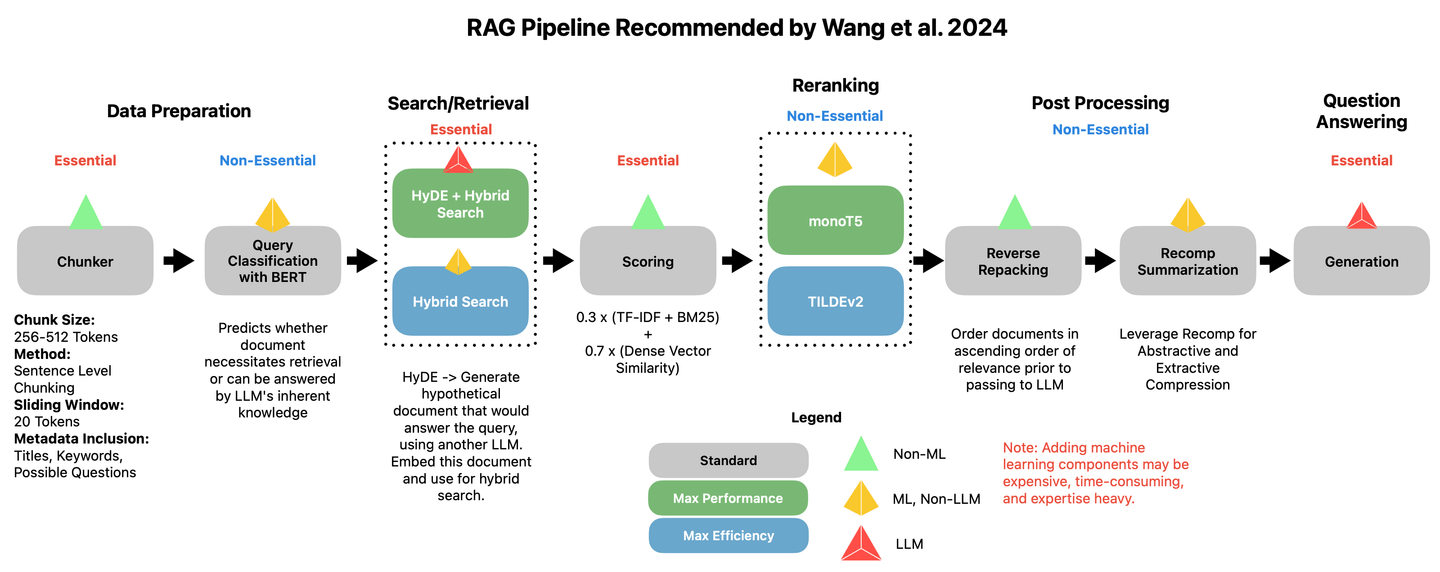
The RAG pipeline recommended by Wang and colleagues.
We'll implement a few of these proposed best-practices, namely the ones which aim to improve the quality of search (Sentence Chunking, HyDE, Reverse Packing).
For brevity, we will omit those techniques focused on improving efficiency (Query Classification and Summarization).
We will also implement a few techniques that were not covered, but which I personally find useful and interesting (Metadata Inclusion, Composite Multi-Field Embeddings, Query Enrichment).
Finally, we'll run a short test to see if the quality of our search results and generated answers has improved versus the baseline. Let's get to it!
RAG overview
RAG aims to enhance LLMs by retrieving information from external knowledge bases to enrich generated answers. By providing domain-specific information, LLMs can be quickly adapted for use cases outside the scope of their training data; significantly cheaper than fine-tuning, and easier to keep up-to-date.
Measures to improve the quality of RAG typically focus on two tracks:
- Enhancing the quality and clarity of the knowledge base.
- Improving the coverage and specificity of search queries.
These two measures will achieve the goal of improving the odds that the LLM has access to relevant facts and information, and is thus less likely to hallucinate or draw upon its own knowledge - which may be outdated or irrelevant.
The diversity of methods is difficult to clarify in just a few sentences. Let's go straight to implementation to make things clearer.
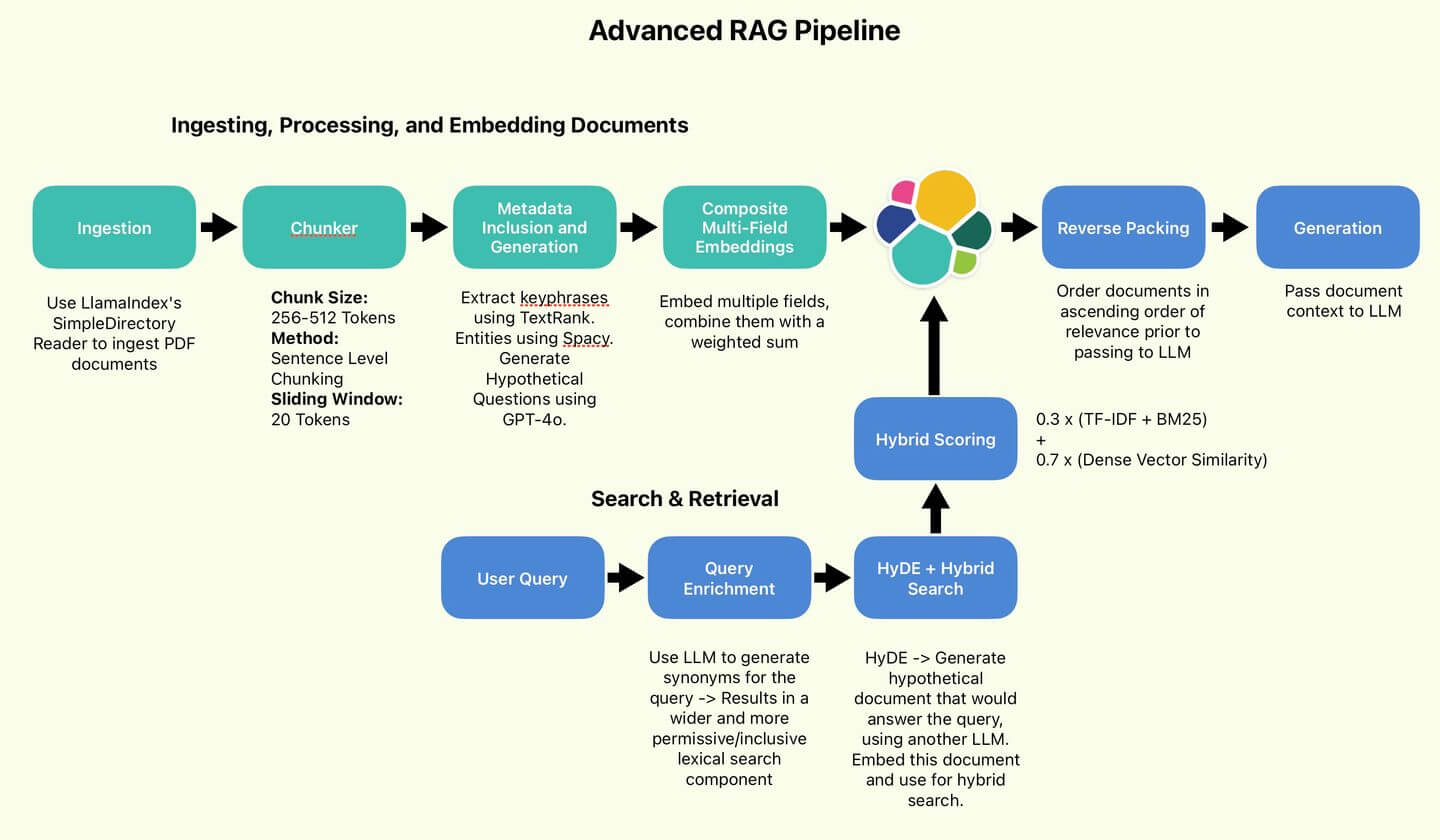
Figure 1: The RAG pipeline used by the author.
Table of contents
Set-up
All code may be found in the Searchlabs repo.
First things first. You will need the following:
- An Elastic Cloud Deployment
- An LLM API - We are using a GPT-4o deployment on Azure OpenAI in this notebook
- Python Version 3.12.4 or later
We will be running all the code from the main.ipynb notebook.
Go ahead and git clone the repo, navigate to supporting-blog-content/advanced-rag-techniques, then run the following commands:
# Create a new virtual environment named 'rag_env'
python -m venv rag_env
# Activate the virtual environment (for Unix-based systems)
source rag_env/bin/activate
# (For Windows)
.\rag_env\Scripts\activate
# Install packages listed in requirements.txt
pip install -r requirements.txtOnce that's done, create a .env file and fill out the following fields (Referenced in .env.example). Credits to my co-author, Claude-3.5, for the helpful comments.
# Elastic Cloud: Found in the 'Deployment' page of your Elastic Cloud
# console
ELASTIC_CLOUD_ENDPOINT=""
ELASTIC_CLOUD_ID=""
# Elastic Cloud: Created during deployment setup or in 'Security'
# settings
ELASTIC_USERNAME=""
ELASTIC_PASSWORD=""
# Elastic Cloud: The name of the index you created in Kibana or via API
ELASTIC_INDEX_NAME=""
# Azure AI Studio: Found in 'Keys and Endpoint' section of your Azure
# OpenAI resource
AZURE_OPENAI_KEY_1=""
AZURE_OPENAI_KEY_2=""
AZURE_OPENAI_REGION=""
AZURE_OPENAI_ENDPOINT=""
# Azure AI Studio: Found in 'Deployments' section of your Azure OpenAI
# resource
AZURE_OPENAI_DEPLOYMENT_NAME=""
# Using BAAI/bge-small-en-v1.5 because I think it is a good balance of
# resource efficiency and performance.
HUGGINGFACE_EMBEDDING_MODEL="BAAI/bge-small-en-v1.5"Next, we'll choose the document to ingest, and place it in the documents folder. For this article, we'll be using the Elastic N.V. Annual Report 2023. It's a pretty challenging and dense document, perfect for stress testing our RAG techniques.

Elastic Annual Report 2023
Now we're all set, let's go to ingestion. Open main.ipynb and execute the first two cells to import all packages and intialize all services.
Ingesting, processing, and embedding documents
Data ingestion
- Personal note: I am stunned by LlamaIndex's convenience. In the olden days before LLMs and LlamaIndex, ingesting documents of various formats was a painful process of collecting esoteric packages from all over. Now it's reduced to a single function call. Wild.
The SimpleDirectoryReader will load every document in the directory_path. For .pdf files, it returns a list of document objects, which I convert to Python dictionaries because I find them easier to work with.
# llamaindex_processor.py
from llama_index.core import SimpleDirectoryReader
class LlamaIndexProcessor:
def __init__(self):
pass
def load_documents(self, directory_path):
'''
Load all documents in directory
'''
reader = SimpleDirectoryReader(input_dir=directory_path)
return reader.load_data()
# main.ipynb
llamaindex_processor=LlamaIndexProcessor()
documents=llamaindex_processor.load_documents('./documents/')
documents=[dict(doc_obj) for doc_obj in documents]Each dictionary contains the key content in the text field. It also contains useful metadata such as page number, filename, file size, and type.
{
'id_': '5f76f0b3-22d8-49a8-9942-c2bbab14f63f',
'metadata': {'page_label': '5',
'file_name': 'Elastic_NV_Annual-Report-Fiscal-Year-2023.pdf',
'file_path': '/Users/han/Desktop/Projects/truckasaurus/documents/Elastic_NV_Annual-Report-Fiscal-Year-2023.pdf',
'file_type': 'application/pdf',
'file_size': 3724426,
'creation_date': '2024-07-27',
'last_modified_date': '2024-07-27'},
'text': 'Table of Contents\nPage\nPART I\nItem 1. Business 3\n15 Item 1A. Risk Factors\nItem 1B. Unresolved Staff Comments 48\nItem 2. Properties 48\nItem 3. Legal Proceedings 48\nItem 4. Mine Safety Disclosures 48\nPART II\nItem 5. Market for Registrant's Common Equity, Related Stockholder Matters and Issuer Purchases of \nEquity Securities49\nItem 6. [Reserved] 49\nItem 7. Management's Discussion and Analysis of Financial Condition and Results of Operations 50\nItem 7A. Quantitative and Qualitative Disclosures About Market Risk 64\nItem 8. Financial Statements and Supplementary Data 66\nItem 9. Changes in and Disagreements With Accountants on Accounting and Financial Disclosure 100\n100\n101Item 9A. Controls and Procedures\nItem 9B. Other Information\nItem 9C. Disclosure Regarding Foreign Jurisdictions That Prevent Inspections 101\nPART III\n102\n102\n102\n102Item 10. Directors, Executive Officers and Corporate Governance\nItem 11. Executive Compensation\nItem 12. Security Ownership of Certain Beneficial Owners and Management, and Related Stockholder Matters \nItem 13. Certain Relationships and Related Transactions, and Director Independence\nItem 14. Principal Accountant Fees and Services 102\nPART IV\n103\n105Item 15. Exhibits and Financial Statement Schedules \nItem 16. Form 10-K Summary\nSignatures 106\ni',
...
}Sentence-level, token-wise chunking
The first thing to do is reduce our documents to chunks of a standard length (to ensure consistency and manageability). Embedding models have unique token limits (maximum input size they can process). Tokens are the basic units of text that models process. To prevent information loss (truncation or omission of content), we should provide text that does not exceed those limits (by splitting longer texts into smaller segments).
Chunking has a significant impact on performance. Ideally, each chunk would represent a self-contained piece of information, capturing contextual information about a single topic. Chunking methods include word-level chunking, where documents are split by word count, and semantic chunking which uses an LLM to identify logical breakpoints.
Word-level chunking is cheap, fast, and easy, but runs a risk of splitting sentences and thus breaking context. Semantic chunking gets slow and expensive, especially if you're dealing with documents like the 116-page Elastic Annual Report.
Let's choose a middleground approach. Sentence level chunking is still simple, but can preserve context more effectively than word-level chunking while being significantly cheaper and faster. Additionally, we'll implement a sliding window to capture some of the surrounding context, and alleviate the impact of splitting paragraphs.
# chunker.py
import uuid
import re
class Chunker:
def __init__(self, tokenizer):
self.tokenizer = tokenizer
def split_into_sentences(self, text):
"""Split text into sentences."""
return re.split(r'(?<=[.!?])\s+', text)
def sentence_wise_tokenized_chunk_documents(self, documents, chunk_size=512, overlap=20, min_chunk_size=50):
'''
1. Split text into sentences.
2. Tokenize using the provided tokenizer method.
3. Build chunks up to the chunk_size limit.
4. Create an overlap based on tokens - to preserve context.
5. Only keep chunks that meet the minimum token size requirement.
'''
chunked_documents = []
for doc in documents:
sentences = self.split_into_sentences(doc['text'])
tokens = []
sentence_boundaries = [0]
# Tokenize all sentences and keep track of sentence boundaries
for sentence in sentences:
sentence_tokens = self.tokenizer.encode(sentence, add_special_tokens=True)
tokens.extend(sentence_tokens)
sentence_boundaries.append(len(tokens))
# Create chunks
chunk_start = 0
while chunk_start < len(tokens):
chunk_end = chunk_start + chunk_size
# Find the last complete sentence that fits in the chunk
sentence_end = next((i for i in sentence_boundaries if i > chunk_end), len(tokens))
chunk_end = min(chunk_end, sentence_end)
# Create the chunk
chunk_tokens = tokens[chunk_start:chunk_end]
# Check if the chunk meets the minimum size requirement
if len(chunk_tokens) >= min_chunk_size:
# Create a new document object for this chunk
chunk_doc = {
'id_': str(uuid.uuid4()),
'chunk': chunk_tokens,
'original_text': self.tokenizer.decode(chunk_tokens),
'chunk_index': len(chunked_documents),
'parent_id': doc['id_'],
'chunk_token_count': len(chunk_tokens)
}
# Copy all other fields from the original document
for key, value in doc.items():
if key != 'text' and key not in chunk_doc:
chunk_doc[key] = value
chunked_documents.append(chunk_doc)
# Move to the next chunk start, considering overlap
chunk_start = max(chunk_start + chunk_size - overlap, chunk_end - overlap)
return chunked_documents
# main.ipynb
# Initialize Embedding Model
HUGGINGFACE_EMBEDDING_MODEL = os.environ.get('HUGGINGFACE_EMBEDDING_MODEL')
embedder=EmbeddingModel(model_name=HUGGINGFACE_EMBEDDING_MODEL)
# Initialize Chunker
chunker=Chunker(embedder.tokenizer)The Chunker class takes in the embedding model's tokenizer to encode and decode text. We'll now build chunks of 512 tokens each, with an overlap of 20 tokens. To do this, we'll split the text into sentences, tokenize those sentences, and then add the tokenized sentences to our current chunk until we cannot add more without breaching our token limit.
Finally, decode the sentences back to the original text for embedding, storing it in a field called original_text. Chunks are stored in a field called chunk. To reduce noise (aka useless documents), we will discard any documents smaller than 50 tokens in length.
Let's run it over our documents:
chunked_documents=chunker.sentence_wise_tokenized_chunk_documents(documents, chunk_size=512)And get back chunks of text that look like this:
print(chunked_documents[4]['original_text'])
[CLS] the aggregate market value of the ordinary shares held by non - affiliates of the registrant,
based on the closing price of the shares of ordinary shares on the new york stock exchange on
october 31, 2022 ( the last business day of the registrant 's second fiscal quarter ), was
approximately $ 6. 1 billion. [SEP] [CLS] as of may 31, 2023, the registrant had 97, 390, 886
ordinary shares, par value €0. 01 per share, outstanding. [SEP] [CLS] documents incorporated by
reference portions of the registrant 's definitive proxy statement relating to the registrant 's 2
023 annual general meeting of shareholders are incorporated by reference into part iii of this annual
...
...Metadata inclusion and generation
We've chunked our documents. Now it's time to enrich the data. I want to generate or extract additional metadata. This additional metadata can be used to influence and enhance search performance.
We'll define a DocumentEnricher class, whose role is to take in a list of documents (Python dictionaries), and a list of processor functions. These functions will run over the documents' original_text column, and store their outputs in new fields.
First, we extract keyphrases using TextRank. TextRank is a graph-based algorithm that extracts key phrases and sentences from text by ranking their importance based on the relationships between words.
Next, we'll generate potential_questions using GPT-4o.
Finally, we'll extract entities using Spacy.
Since the code for each of these is quite lengthy and involved, I will refrain from reproducing it here. If you are interested, the files are marked in the code samples below.
Let's run the data enrichment:
# documentenricher.py
from tqdm import tqdm
class DocumentEnricher:
def __init__(self):
pass
def enrich_document(self, documents, processors, text_col='text'):
for doc in tqdm(documents, desc="Enriching documents using processors: "+str(processors)):
for (processor, field) in processors:
metadata=processor(doc[text_col])
if isinstance(metadata, list):
metadata='\n'.join(metadata)
doc.update({field: metadata})
# main.ipynb
# Initialize processor classes
nltkprocessor=NLTKProcessor() // nltk_processor.py
entity_extractor=EntityExtractor() // entity_extractor.py
gpt4o = LLMProcessor(model='gpt-4o') // llm.py
# Initialize LLM
documentenricher=DocumentEnricher()
# Create new fields in the documents - These are the outputs of the processor functions.
processors=[
(nltkprocessor.textrank_phrases, "keyphrases"),
(gpt4o.generate_questions, "potential_questions"),
(entity_extractor.extract_entities, "entities")
]
# .enrich_document() will modify chunked_docs in place.
# To view the results, we'll print chunked_docs in the next few cells!
documentenricher.enrich_document(chunked_docs, text_col='original_text', processors=processors)And take a look at the results:
Keyphrases extracted by TextRank
These keyphrases are a stand-in for the chunk's core topics. If a query has to do with cybersecurity, this chunk's score will be boosted.
print(chunked_documents[25]['keyphrases'])
'elastic agent stop', 'agent stop malware',
'stop malware ransomware', 'malware ransomware environment',
'ransomware environment wide', 'environment wide visibility',
'wide visibility threat', 'visibility threat detection',
'sep cl key', 'cl key feature'Potential questions generated by GPT-4o
These potential questions may directly match with user queries, offering a boost in score. We prompt GPT-4o to generate questions which can be answered using the information found in the current chunk.
print(chunked_documents[25]['potential_questions'])
1. What are the primary functions that Elastic Agent provides in terms of cybersecurity?
2. Describe how Logstash contributes to data management within an IT environment.
3. List and explain any key features of Logstash mentioned in the document.
4. How does Elastic Agent enhance environment-wide visibility in threat detection?
5. What capabilities does Logstash offer for handling data beyond simple collection?
6. In what ways does the document suggest that Elastic Agent stops malware and ransomware?
7. Can you identify any relationships between the functionalities of Elastic Agent and Logstash in an integrated environment?
8. What implications might the advanced threat detection capabilities of Elastic Agent have for organizational security policies?
9. Compare and contrast the roles of Elastic Agent and Logstash based on their described functions.
10. How might the centralized collection ability of Logstash support the threat detection capabilities of Elastic Agent?Entities extracted by Spacy
These entities serve a similar purpose to the keyphrases, but capture organizations' and individuals' names, which keyphrase extraction may miss.
print(chunked_documents[29]['entities'])
'appdynamics', 'apm data', 'azure sentinel',
'microsoft', 'mcafee', 'broadcom', 'cisco',
'dynatrace', 'coveo', 'lucidworks'Composite multi-field embeddings
Now that we have enriched our documents with additional metadata, we can leverage this information to create more robust and context-aware embeddings.
Let's review our current point in the process. We've got four fields of interest in each document.
{
"chunk": "...",
"keyphrases": "...",
"potential_questions": "...",
"entities": "..."
}Each field represents a different perspective on the document's context, potentially highlighting a key area for the LLM to focus on.
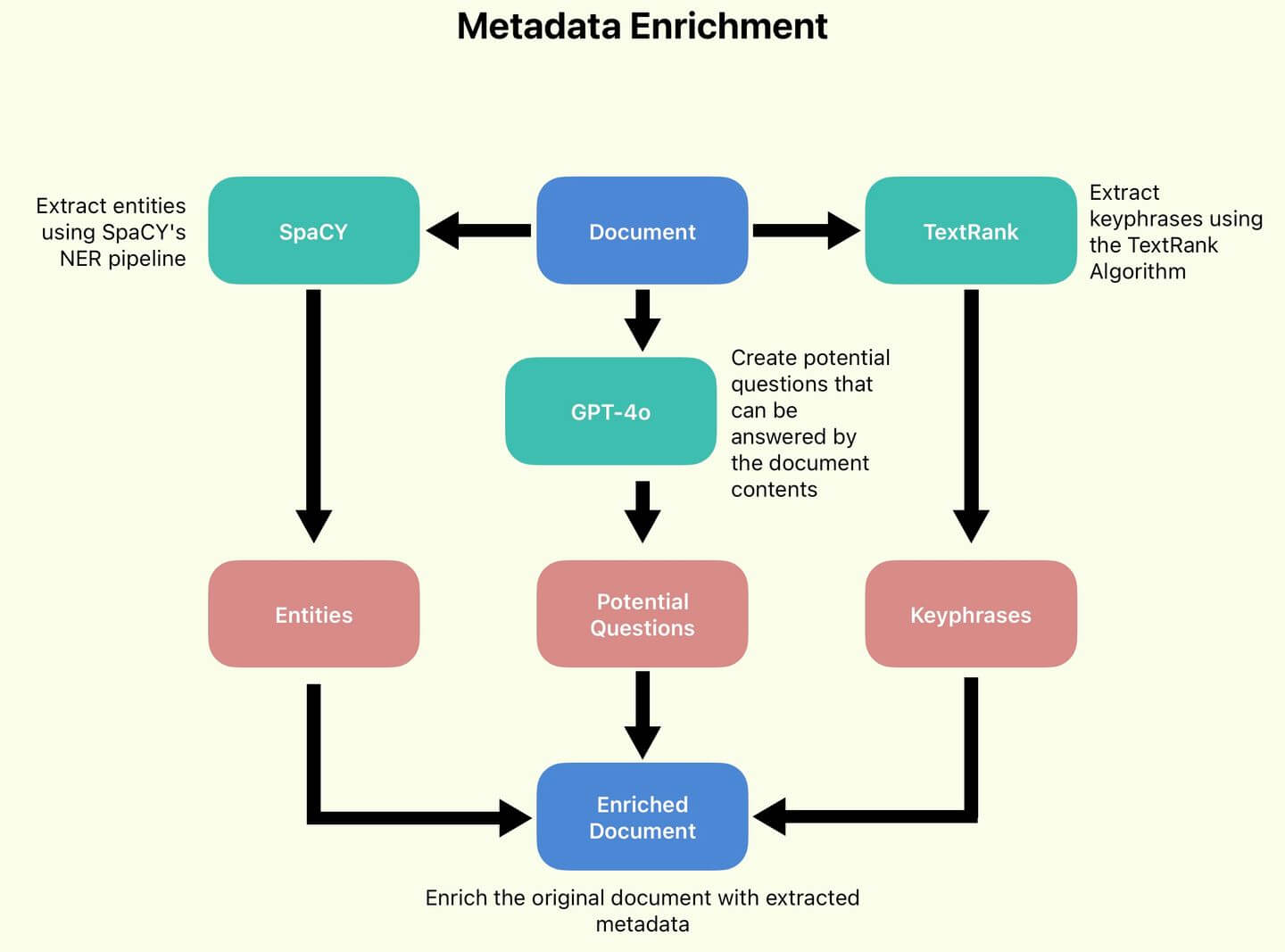
Metadata Enrichment Pipeline
The plan is to embed each of these fields, and then create a weighted sum of the embeddings, known as a Composite Embedding.
With luck, this Composite Embedding will allow the system to become more context aware, in addition to introducing another tunable hyperparameter from controlling the search behavior.
First, let's embed each field and update each document in place, using our locally defined embedding model imported at the beginning of the main.ipynb notebook.
# EmbeddingModel defined in embedding_model.py
embedder=EmbeddingModel(model_name=HUGGINGFACE_EMBEDDING_MODEL)
cols_to_embed=['keyphrases', 'potential_questions', 'entities']
embedding_cols=[]
for col in cols_to_embed:
# Works on text input
embedding_col=embedder.embed_documents_text_wise(chunked_documents, text_field=col)
embedding_cols.append(embedding_col)
# Works on token input
embedding_col=embedder.embed_documents_token_wise(chunked_documents, token_field="chunk")
embedding_cols.append(embedding_col)Each embedding function returns the embedding's field, which is just the original input field with an _embedding postfix.
Let's now define the weightings of our composite embedding:
embedding_cols=[
'keyphrases_embedding',
'potential_questions_embedding',
'entities_embedding',
'chunk_embedding']
combination_weights=[
0.1,
0.15,
0.05,
0.7
]The weightings allow you to assign priorities to each component, based on your usecase and the quality of your data. Intuitively, the size of these weightings is dependent on the semantic value of each component. Since the chunk text itself is by far the richest, I assign a weighting of 70%. Since the entities are the smallest, being just a list of org or person names, I assign it a weighting of 5%. The precise setting for these values has to be determined empirically, on a use-case by use-case basis.
Finally, let's write a function to apply the weightings, and create our composite embedding. We'll delete all the component embeddings as well to save space.
from tqdm import tqdm
def combine_embeddings(objects, embedding_cols, combination_weights, primary_embedding='primary_embedding'):
# Ensure the number of weights matches the number of embedding columns
assert len(embedding_cols) == len(combination_weights), "Number of embedding columns must match number of weights"
# Normalize weights to sum to 1
weights = np.array(combination_weights) / np.sum(combination_weights)
for obj in tqdm(objects, desc="Combining embeddings"):
# Initialize the combined embedding
combined = np.zeros_like(obj[embedding_cols[0]])
# Compute the weighted sum
for col, weight in zip(embedding_cols, weights):
combined += weight * np.array(obj[col])
# Add the new combined embedding to the object
obj.update({primary_embedding:combined.tolist()})
# Remove the original embedding columns
for col in embedding_cols:
obj.pop(col, None)
combine_embeddings(chunked_documents, embedding_cols, combination_weights)With this, we've completed our document processing. We now have a list of document objects which look like this:
{ 'id_': '7fe71686-5cd0-4831-9e79-998c6dbeae0c', 'chunk': [2312, 14613, ...], 'original_text': 'if an emerging growth company, indicate by check mark if the registrant has elected not to use the extended ...', 'chunk_index': 3, 'chunk_token_count': 399, 'metadata': {'page_label': '3', 'file_name': 'Elastic_NV_Annual-Report-Fiscal-Year-2023.pdf', ... 'keyphrases': 'sep cl unk\ncheck mark registrant\ncl unk indicate\nunk indicate check\nindicate check mark\nprincipal executive office\naccelerate filer unk\ncompany unk emerge\nunk emerge growth\nemerge growth company', 'potential_questions': '1. What are the different types of registrant statuses mentioned in the document?\n2. Under what section of the Sarbanes-Oxley Act must registrants file a report on the effectiveness of their internal ...', 'entities': 'the effe ctiveness of\nsection 13\nSEP\nUNK\nsection 21e\n1934\n1933\nu. s. c.\nsection 404\nsection 12\nal', 'primary_embedding': [-0.3946287803351879, -0.17586839850991964, ...] }Indexing to Elastic
Let's bulk upload our documents to Elastic Search. For this purpose, I long-ago defined a set of Elastic Helper functions in elastic_helpers.py. It is a very lengthy piece of code so let's sticking to looking at the function calls.
es_bulk_indexer.bulk_upload_documents works with any list of dictionary objects, taking advantage of Elasticsearch's convenient dynamic mappings.
# Initialize Elasticsearch
ELASTIC_CLOUD_ID = os.environ.get('ELASTIC_CLOUD_ID')
ELASTIC_USERNAME = os.environ.get('ELASTIC_USERNAME')
ELASTIC_PASSWORD = os.environ.get('ELASTIC_PASSWORD')
ELASTIC_CLOUD_AUTH = (ELASTIC_USERNAME, ELASTIC_PASSWORD)
es_bulk_indexer = ESBulkIndexer(cloud_id=ELASTIC_CLOUD_ID, credentials=ELASTIC_CLOUD_AUTH)
es_query_maker = ESQueryMaker(cloud_id=ELASTIC_CLOUD_ID, credentials=ELASTIC_CLOUD_AUTH)
# Define Index Name
index_name=os.environ.get('ELASTIC_INDEX_NAME')
# Create index and bulk upload
index_exists = es_bulk_indexer.check_index_existence(index_name=index_name)
if not index_exists:
logger.info(f"Creating new index: {index_name}")
es_bulk_indexer.create_es_index(es_configuration=BASIC_CONFIG, index_name=index_name)
success_count = es_bulk_indexer.bulk_upload_documents(
index_name=index_name,
documents=chunked_documents,
id_col='id_',
batch_size=32
)Head on over to Kibana and verify that all documents have been indexed. There should be 224 of them. Not bad for such a large document!
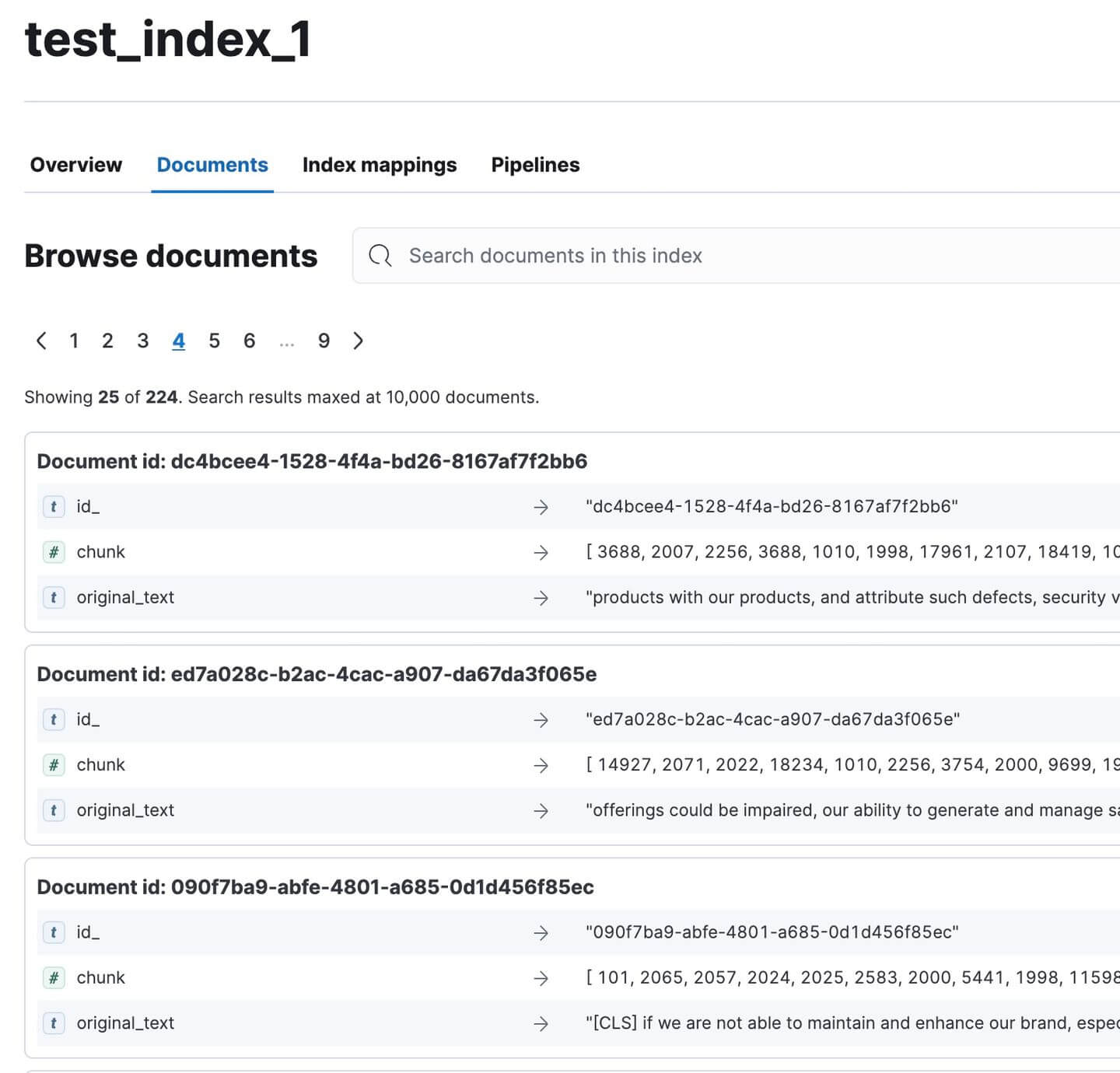
Indexed Annual Report Documents in Kibana
Cat break
Let's take a break, article's a little heavy, I know. Check out my cat:

look at how furious she is
Adorable. The hat went missing and I half suspect she stole and hid it somewhere :(
Congrats on making it this far :)
Join me in Part 2 for testing and evaluation of our RAG pipeline!
Appendix
Definitions
1. Sentence Chunking
- A preprocessing technique used in RAG systems to divide text into smaller, meaningful units.
- Process:
- Input: Large block of text (e.g., document, paragraph)
- Output: Smaller text segments (typically sentences or small groups of sentences)
- Purpose:
- Creates granular, context-specific text segments
- Allows for more precise indexing and retrieval
- Improves the relevance of retrieved information in RAG systems
- Characteristics:
- Segments are semantically meaningful
- Can be independently indexed and retrieved
- Often preserves some context to ensure standalone comprehensibility
- Benefits:
- Enhances retrieval precision
- Enables more focused augmentation in RAG pipelines
2. HyDE (Hypothetical Document Embedding)
- A technique that uses an LLM to generate a hypothetical document for query expansion in RAG systems.
- Process:
- Input query to an LLM
- LLM generates a hypothetical document answering the query
- Embed the generated document
- Use the embedding for vector search
- Key difference:
- Traditional RAG: Matches query to documents
- HyDE: Matches documents to documents
- Purpose:
- Improve retrieval performance, especially for complex or ambiguous queries
- Capture richer semantic context than a short query
- Benefits:
- Leverages LLM's knowledge to expand queries
- Can potentially improve relevance of retrieved documents
- Challenges:
- Requires additional LLM inference, increasing latency and cost
- Performance depends on quality of generated hypothetical document
3. Reverse Packing
- A technique used in RAG systems to reorder search results before passing them to the LLM.
- Process:
- Search engine (e.g., Elasticsearch) returns documents in descending order of relevance.
- The order is reversed, placing the most relevant document last.
- Purpose:
- Exploits the recency bias of LLMs, which tend to focus more on the latest information in their context.
- Ensures the most relevant information is "freshest" in the LLM's context window.
- Example: Original order: [Most Relevant, Second Most, Third Most, ...] Reversed order: [..., Third Most, Second Most, Most Relevant]
4. Query Classification
- A technique to optimize RAG system efficiency by determining whether a query requires RAG or can be answered directly by the LLM.
- Process:
- Develop a custom dataset specific to the LLM in use
- Train a specialized classification model
- Use the model to categorize incoming queries
- Purpose:
- Improve system efficiency by avoiding unnecessary RAG processing
- Direct queries to the most appropriate response mechanism
- Requirements:
- LLM-specific dataset and model
- Ongoing refinement to maintain accuracy
- Benefits:
- Reduces computational overhead for simple queries
- Potentially improves response time for non-RAG queries
5. Summarization
- A technique to condense retrieved documents in RAG systems.
- Process:
- Retrieve relevant documents
- Generate concise summaries of each document
- Use summaries instead of full documents in the RAG pipeline
- Purpose:
- Improve RAG performance by focusing on essential information
- Reduce noise and interference from less relevant content
- Benefits:
- Potentially improves relevance of LLM responses
- Allows for inclusion of more documents within context limits
- Challenges:
- Risk of losing important details in summarization
- Additional computational overhead for summary generation
6. Metadata Inclusion
- A technique to enrich documents with additional contextual information.
- Types of metadata:
- Keyphrases
- Titles
- Dates
- Authorship details
- Blurbs
- Purpose:
- Increase contextual information available to the RAG system
- Provide LLMs with clearer understanding of document content and relevance
- Benefits:
- Potentially improves retrieval accuracy
- Enhances LLM's ability to assess document usefulness
- Implementation:
- Can be done during document preprocessing
- May require additional data extraction or generation steps
7. Composite Multi-Field Embeddings
- An advanced embedding technique for RAG systems that creates separate embeddings for different document components.
- Process:
- Identify relevant fields (e.g., title, keyphrases, blurb, main content)
- Generate separate embeddings for each field
- Combine or store these embeddings for use in retrieval
- Difference from standard approach:
- Traditional: Single embedding for entire document
- Composite: Multiple embeddings for different document aspects
- Purpose:
- Create more nuanced and context-aware document representations
- Capture information from a wider variety of sources within a document
- Benefits:
- Potentially improves performance on ambiguous or multi-faceted queries
- Allows for more flexible weighting of different document aspects in retrieval
- Challenges:
- Increased complexity in embedding storage and retrieval processes
- May require more sophisticated matching algorithms
8. Query Enrichment
- A technique to expand the original query with related terms to improve search coverage.
- Process:
- Analyze the original query
- Generate synonyms and semantically related phrases
- Augment the query with these additional terms
- Purpose:
- Increase the range of potential matches in the document corpus
- Improve retrieval performance for queries with specific or technical language
- Benefits:
- Potentially retrieves relevant documents that don't exactly match the original query terms
- Can help overcome vocabulary mismatch between queries and documents
- Challenges:
- Risk of query drift if not carefully implemented
- May increase computational overhead in the retrieval process
Ready to try this out on your own? Start a free trial.
Elasticsearch has integrations for tools from LangChain, Cohere and more. Join our advanced semantic search webinar to build your next GenAI app!
Related content

October 23, 2025
Low-memory benchmarking in DiskBBQ and HNSW BBQ
Benchmarking Elasticsearch latency, indexing speed, and memory usage for DiskBBQ and HNSW BBQ in low-memory environments.

October 22, 2025
Deploying a multilingual embedding model in Elasticsearch
Learn how to deploy an e5 multilingual embedding model for vector search and cross-lingual retrieval in Elasticsearch.

October 23, 2025
Introducing a new vector storage format: DiskBBQ
Introducing DiskBBQ, an alternative to HNSW, and exploring when and why to use it.
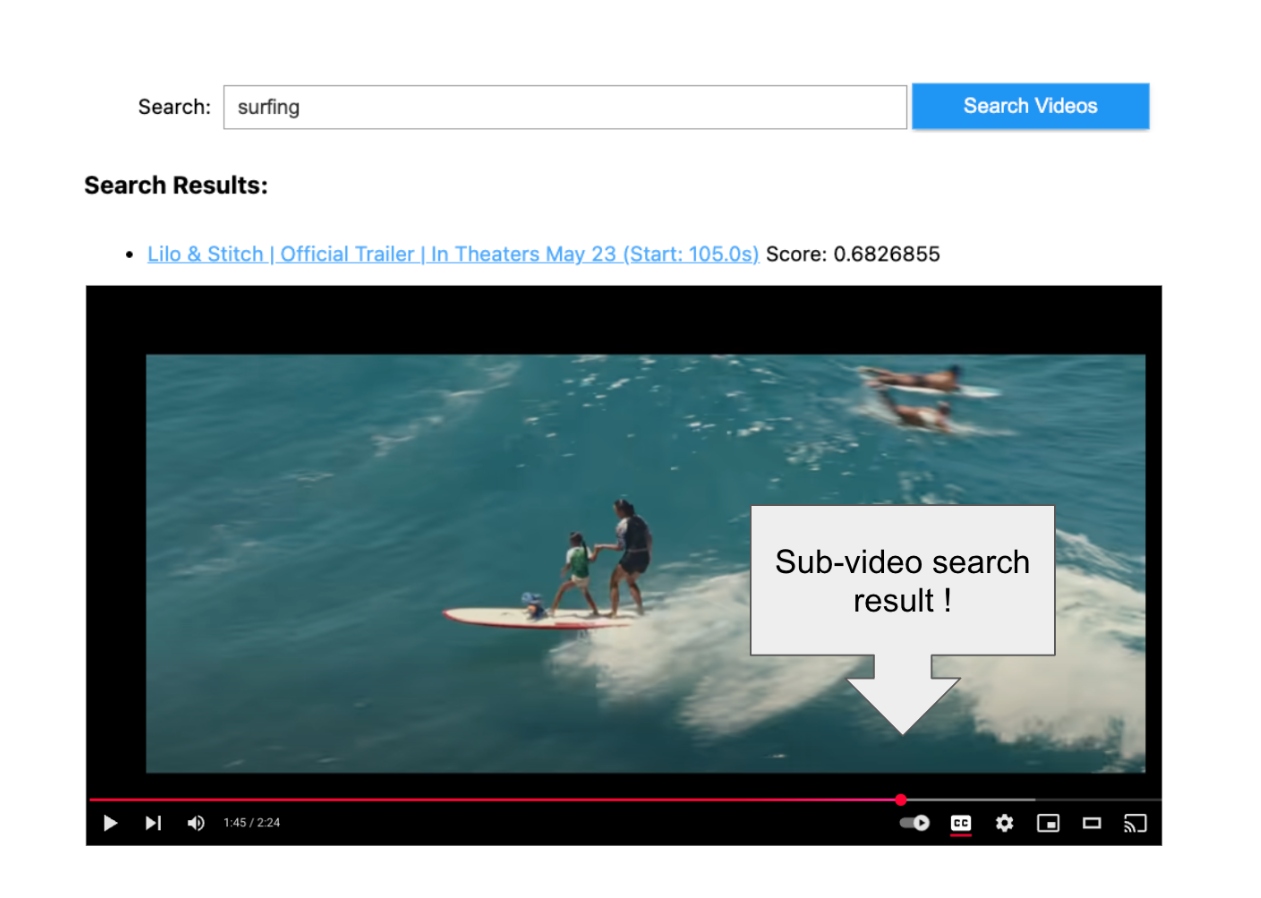
September 19, 2025
Using TwelveLabs’ Marengo video embedding model with Amazon Bedrock and Elasticsearch
Creating a small app to search video embeddings from TwelveLabs' Marengo model.
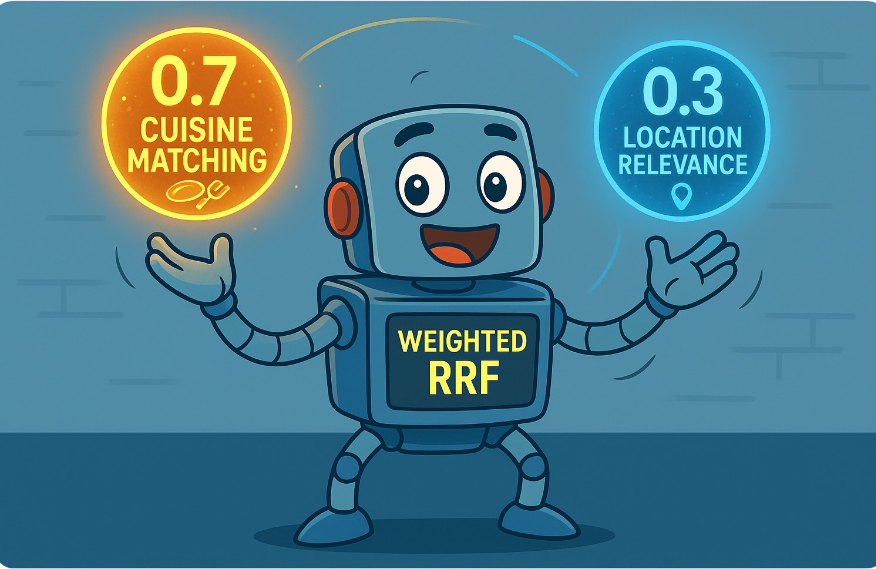
September 15, 2025
Balancing the scales: Making reciprocal rank fusion (RRF) smarter with weights
Exploring weighted reciprocal rank fusion (RRF) in Elasticsearch and how it works through practical examples.